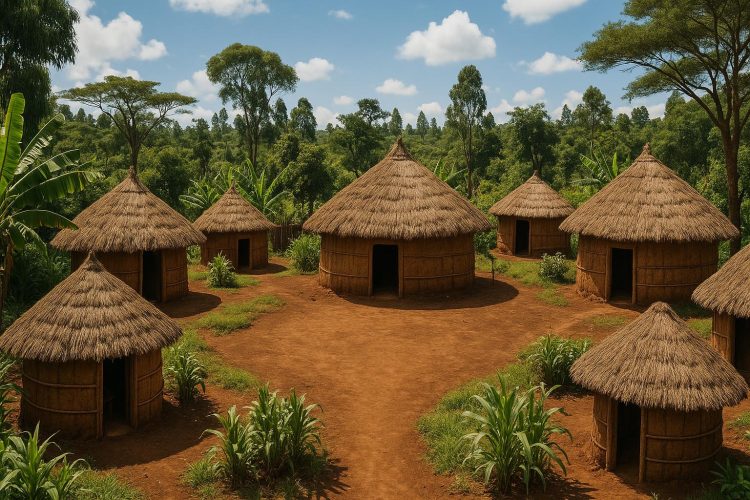Introduction to Traditional Kikuyu Villages
The Kikuyu community, a prominent ethnic group in Kenya, is known for its extensive cultural heritage. Their traditional village setup is a reflection of this heritage, characterized by unique architectural styles, social structures, and cultural practices. This exploration will delve deeper into the various facets that compose the traditional Kikuyu villages, providing a comprehensive understanding of their way of life.
Village Layout and Architecture
Traditional Kikuyu villages exhibit a distinctive circular pattern in their layout. This arrangement is symbolic of the unity and protection that is essential within the community. The central courtyard of the village is not just a physical space; it represents a focal point where communal gatherings and ceremonies are held. This area plays a pivotal role in fostering community bonds and serves as the heart of social interactions in the village.
The huts surrounding this courtyard are typically constructed using locally available materials like mud, straw, and wood. These materials are not chosen merely for their availability but also for their effectiveness. The wooden frames of the huts are robust, providing a sturdy structure, while the mud walls offer insulation against both heat and cold. The roofs are covered with grass thatch, a material that not only ensures protection from the elements but is also renewably sourced. This traditional architectural style showcases the community’s deep respect for nature and sustainability.
Types of Huts
In a traditional Kikuyu village, there are primarily two types of huts that serve distinct functions within the community.
The thingira stands as a central structure in every Kikuyu homestead, symbolizing the patriarchal focus of the society. As the men’s hut, it is a space reserved for the male members of the family to engage in discussions about important matters affecting the community or family. The thingira also serves as a transitional space for young boys, who sleep there as part of their journey into adulthood, learning from the elders in their community.
The second type of hut is the family hut, which is usually larger and occupied by women and children. This hut is where the bulk of daily household activities take place. Designed for convenience and safety, it provides a nurturing environment for family members. These spaces are the domain of the women, who manage the household and care for the children, ensuring the continuity of family and cultural traditions.
Social Organization
The social organization within a traditional Kikuyu village is primarily patriarchal, with distinct roles and responsibilities assigned based on gender and age. Elders hold a place of high esteem, as their wisdom and experience are invaluable to the harmony and function of the community. They are responsible for making significant decisions and are integral in resolving disputes, maintaining order, and ensuring that cultural norms and values are upheld.
The community is organized into clans, each tracing its lineage back to a common forebear. This clan system not only strengthens familial bonds but also fosters a strong sense of identity and community belonging. Members of a clan often engage in cooperative activities, share resources, and support one another in times of need, reinforcing social cohesion and collective strength.
Role of Agriculture
Agriculture forms the backbone of sustenance in traditional Kikuyu villages, deeply embedded in their cultural practices. The Kikuyu people are predominantly agriculturists, with farming techniques and crop selection reflecting their intimate understanding of the local environment. Crops like maize, beans, and sweet potatoes are staples, cultivated using methods that have been passed down through generations.
Livestock farming complements agriculture, with cattle, goats, and chickens providing vital resources such as milk and meat. These agricultural activities are not solitary endeavors but are often community-based, promoting the sharing of labor and resources. This collective approach ensures food security and reinforces the communal spirit of the Kikuyu people.
Cultural Practices and Ceremonies
Traditional Kikuyu culture is rich with ceremonies and rituals that demarcate the various stages of life, from birth to marriage, and eventually, to death. These ceremonies are more than personal milestones; they are communal events that strengthen social ties and reinforce cultural values.
One prominent example is the ngurario, the traditional marriage ceremony. This elaborate ritual is not merely a personal affair but involves the union of two families. The ceremony includes negotiations, gift exchanges, and rituals that signify mutual respect and partnership between the families involved.
Conclusion
Exploring the intricacies of traditional Kikuyu villages provides valuable insight into the cultural ethos of the Kikuyu people. While modern influences have inevitably led to changes in these traditional setups, the fundamental values and customs continue to play a crucial role in shaping the identity of the Kikuyu community. For those interested in further exploring this rich cultural tapestry, numerous resources from educational institutions and cultural heritage organizations offer in-depth studies on indigenous cultures and practices. Whether through academic research, cultural exchanges, or community engagement, these resources serve as valuable tools for understanding and preserving the heritage of the Kikuyu people.
